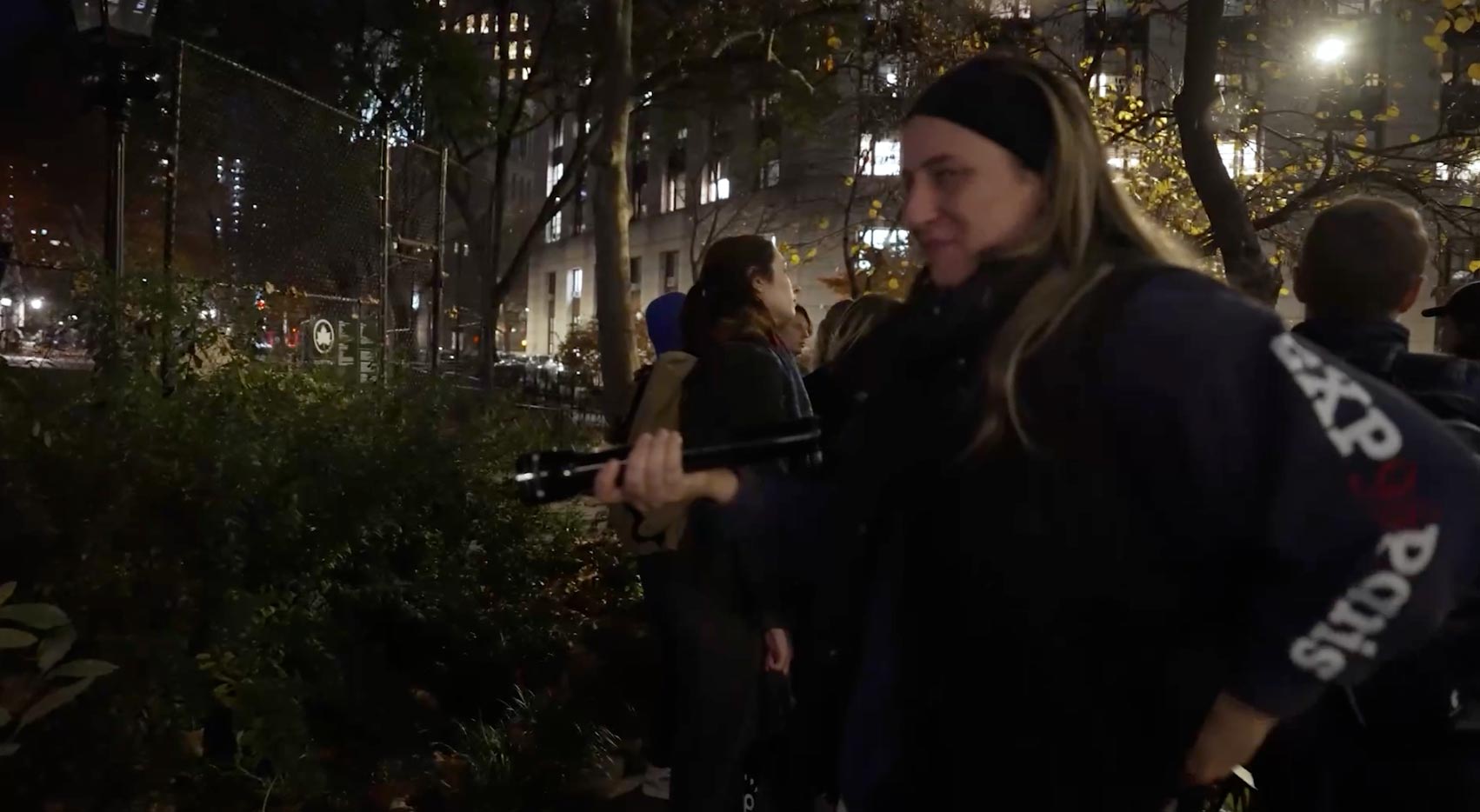
The Rat Pack
By Assaf Yona Olshansky-Gefen
On a cold November night, a small group of New Yorkers gathered at Columbus Park on the Lower East Side to attend a rat walk. Each attendee came with their own experience and understanding of these rodents, but they shared the common goal of learning about rat behavior and the ways they can help reduce the city’s rat population.
Flashlights in hand, this small group became the park’s rat inspectors for the next two hours. But perhaps a more fitting name is “rat warriors,” because the walk was led by New York City’s first-ever Rat Czar, Kathleen Corradi.
“People ask me if my title as ‘Rat Czar’ brings humor to the role, and my real take is that it brings attention to the issue, which to me means potential [sic] to get more New Yorkers involved,” she said.
Corradi, whose official role is Citywide Director of Rodent Mitigation, was appointed by Mayor Eric Adams in April 2023.
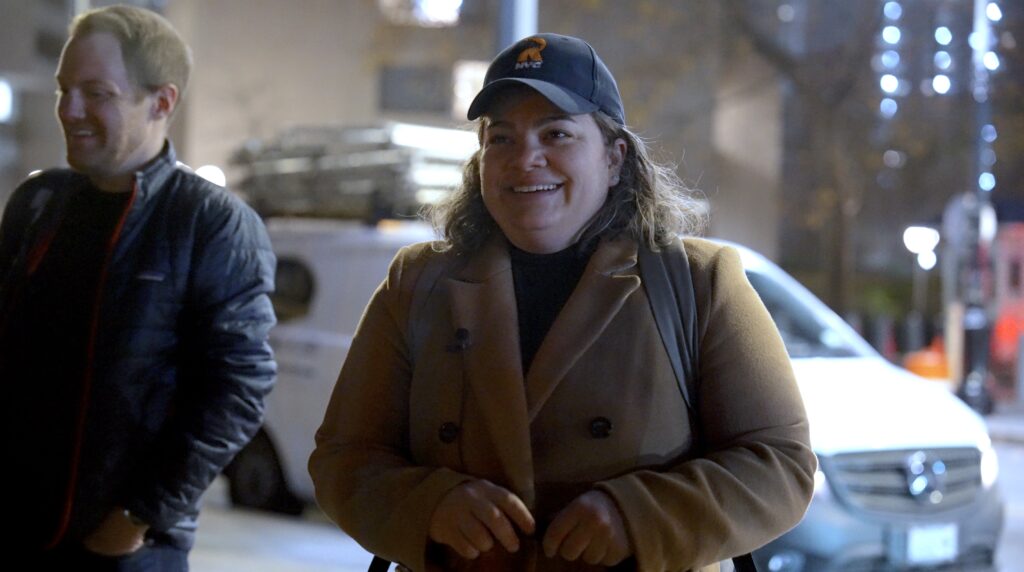
Kathleen Corradi, New York City’s first-ever Rat Czar. Photo: Assaf Yona Olshansky-Gefen
The rat walk is part of the city’s latest effort to reduce the rat population by involving the public. In July 2024, Adams and Corradi started a community outreach program called the “Rat Pack.” Any New Yorker can become a member of the Rat Pack, but they must complete three tasks.
First, prospective members need to attend a two-hour Rat Academy session hosted by the NYC Department of Health. Second, they must participate in a service volunteer project, like a park cleanup or gardening event. Finally, they must attend a rat walk with the Rat Czar.
“We cannot exterminate our way out of this issue. If we want to get to sustained rat reduction, we need integrated pest management and that takes everyone,” Corradi argued.
The Rat Pack webpage says that members will be “deputized” to “educate, engage, and take action on all things rat mitigation.”
They also get their hands on the highly desirable official Rat Pack merchandise.
According to Caroline Bragdon, the director of Neighborhood Interventions for Pest Control Services, the need for a community-oriented rat mitigation initiative in New York City like the Rat Pack is overdue.
She said that post-pandemic, a growing number of properties were failing rat inspections and fewer properties were successfully remediating rat activity even after the owner had been instructed by the city to do so.
“What we decided is that we needed a more robust community outreach approach so that property owners knew exactly what they were supposed to do and understood the best practices,” she said.
Adams claims to be the city’s most anti-rat mayor. But there is a long history of mayors declaring war on these rodents.
In 1948, Mayor William O’Dwyer established a special rat control committee in response to a perceived increase in the rat population. However, the mayor wasn’t especially successful as the Board of Health described rat infestations as “widespread throughout the entire City” in 1964.
Three decades later, Mayor Rudy Giuliani created the Interagency Rodent Extermination Task Force, the city’s strongest extermination effort up until then. Although the task force raised the city’s rodent-control budget to $8 million, it too proved to be unsuccessful.
During Mayor Michael Bloomberg’s final year in office, the Metropolitan Transportation Authority experimented with a failed sterilization program on the subway’s rats. Four years later in 2017, under Mayor Bill de Blasio, the city began stuffing dry ice into rat burrows.
Last year, Adams called rats “public enemy number one.” Today, New York City is home to as many as three million rats, an increase of 51% since 2010.
The city’s 2024 Rat Pack initiative stands out because of its focus on community education and engagement, shifting the focus away from past policies of extermination.
Attending a Rat Academy session is one of the requirements to join the Rat Pack, but the Department of Health launched the Academy in 2010. Initially, its purpose was to educate supers on how to deal with the rats in their buildings.
Nowadays, the Academy teaches prospective Rat Pack members about rat biology and behavior and gives them instructions on the most effective ways to get rid of the rats on their property.
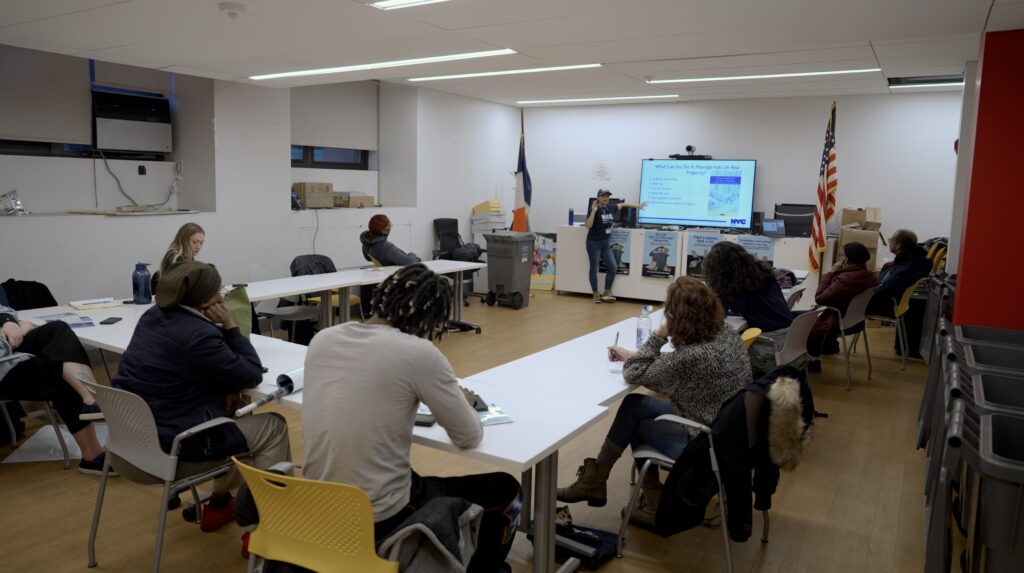
Rat Academy session at the Brownsville Neighborhood Health Action Center. Photo: Assaf Yona Olshansky-Gefen.
I attended a Rat Academy session in the basement unit of the Brownsville Neighborhood Health Action Center. There were a dozen people in attendance, both young and old.
This Academy session was led by Martha Vernazza, a community coordinator at the Department of Health. Vernazza stressed that there is only one way to effectively eliminate rats: attack their food, shelter, and water source, or their triangle of life.
“Instead of thinking ‘kill, kill, kill,’ we have to know how to affect their livelihood to stop their reproduction. There is no shortcut,” she said.
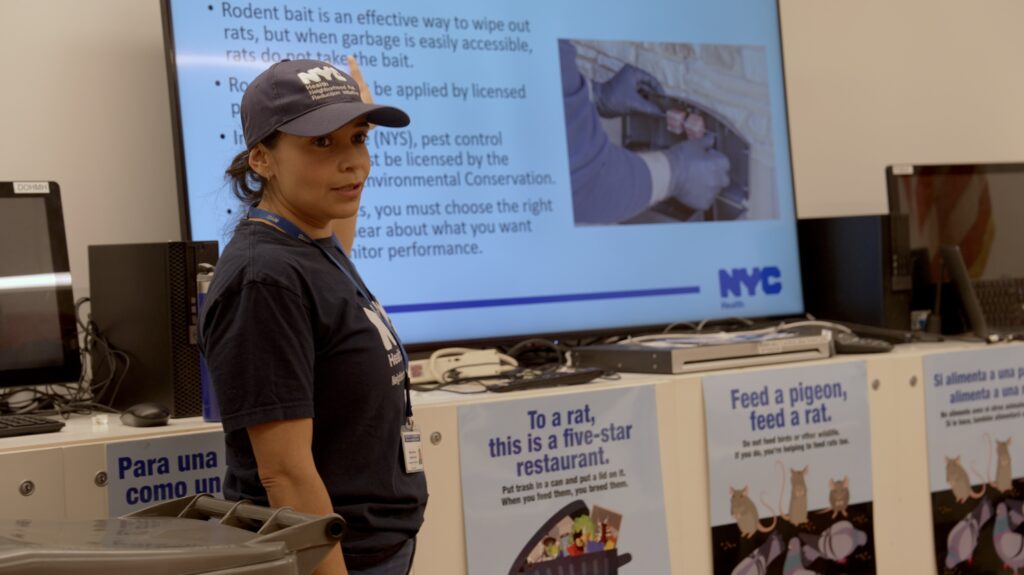
Martha Vernazza at the Rat Academy. Photo: Assaf Yona Olshansky-Gefen.
In addition to eight rat-proof garbage cans, there were several posters freely available to the attendees. One of them read, “To a rat, this is a five-star restaurant,” with a graphic of an overfilled garbage can, referencing the city’s containerization efforts.
Another poster read, “Feed a pigeon, feed a rat,” with a graphic of a flock of pigeons and rats feeding on the same seeds.
Larry the Bird Man, who has been feeding the pigeons at Washington Square Park for the past 14 years, disagrees with this message. He rejects that he is a force behind the city’s rodent problem by feeding the pigeons.
“The rats don’t come out here because of this,” he said. “This,” pointing to a trash can, “helps the rats.”
The real problem, he believes, lies with the government.
“They’re the rats. They’re taking all our money.”
After completing the Rat Academy, soon-to-be Pack members must go on a rat walk with the Rat Czar.
While the Academy and service volunteer projects existed before the creation of the Rat Pack last summer, the rat walk was a completely new initiative. New York’s rat walk follows another community rat walk organized by Washington, D.C.’s Mayor Muriel Bowser in 2017.
“We knew we needed something that turned New Yorkers’ fear and fascination with rats into empowerment and action,” Corradi said.
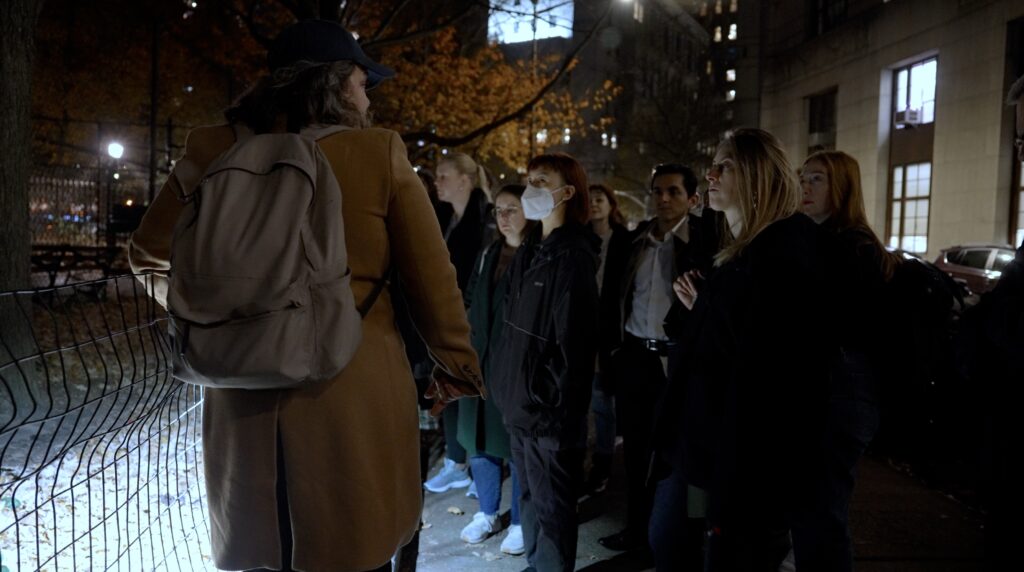
Kathleen Corradi leading the rat walk. Photo: Assaf Yona Olshansky-Gefen.
She said close to one thousand New Yorkers have signed up to participate in a rat walk. Each person had their own reason for wanting to become part of the Rat Pack.
Melissa Kowalski, an East Village resident, told me how she wanted to learn more about rat prevention because after coming back home from traveling, she found remnants of food on the floor and started to hear noises at night.
“I eventually put out traps and I heard them moving through the traps,” she recalled.
Brooke Puleo and Laura Small, two friends on the walk together, had a different motivation for joining the Rat Pack.
“We get merch, which is definitely a motivator for me,” Puleo said. “I also have a stupid sense of humor so I think it’s funny.”
“It’s a fun thing to tell someone we went on a rat walk. It’s definitely going on my resume,” Small joked.
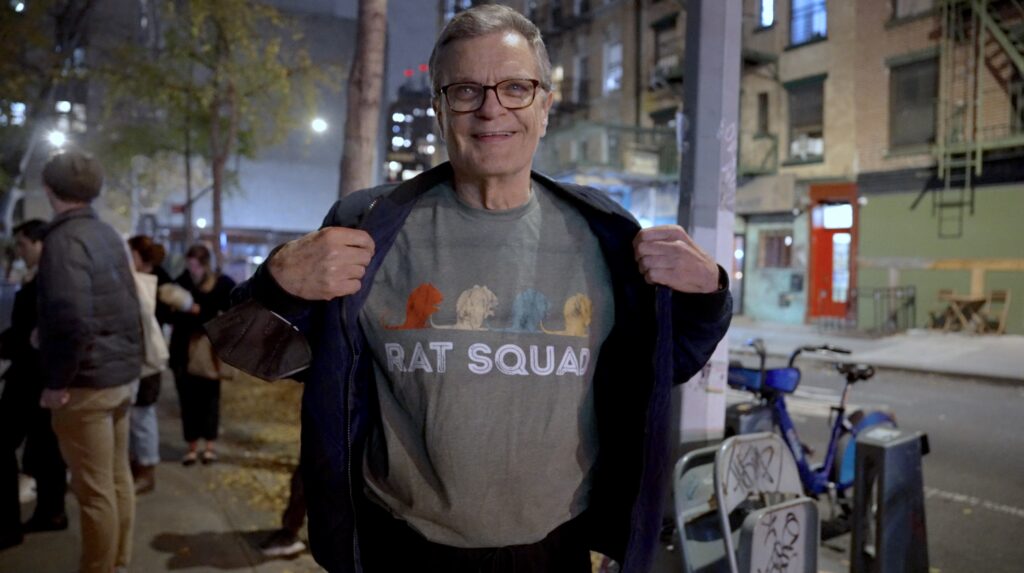
Jim Lyles at the rat walk. Photo: Assaf Yona Olshansky-Gefen.
Representing the W 75th Street Block Association, Jim Lyles joined the walk wearing a colorful t-shirt he ordered off Amazon with “Rat Squad” written on it. He had been tasked with rat mitigation on his block by the association.
“A lot of the landlords have cemented over the gardens we have in front of our apartments because of the rats. I’d like not to see more cement go up, I’d like for the rats to leave,” he said.
On the rat walk, Corradi stressed that rats can chew through cement and turn it into a structural burrow.
“They don’t just need an earthen surface, they can chew through anything less strong than steel. So, cement – no trouble,” she clarified.
To the rat walk warriors, the Rat Pack is an important initiative.
“It’s an uphill battle but I think more efforts like the Rat Pack will help tremendously,” Lyles said.
Steven Grey, a self-described “rat expert” and rat specialist for a pest control company in Hartford, Connecticut, agreed with Lyles.
“These types of initiatives definitely have the potential to be successful,” he said. “The only reason rats thrive is because nobody is doing anything about it. We’re here doing something about it.”
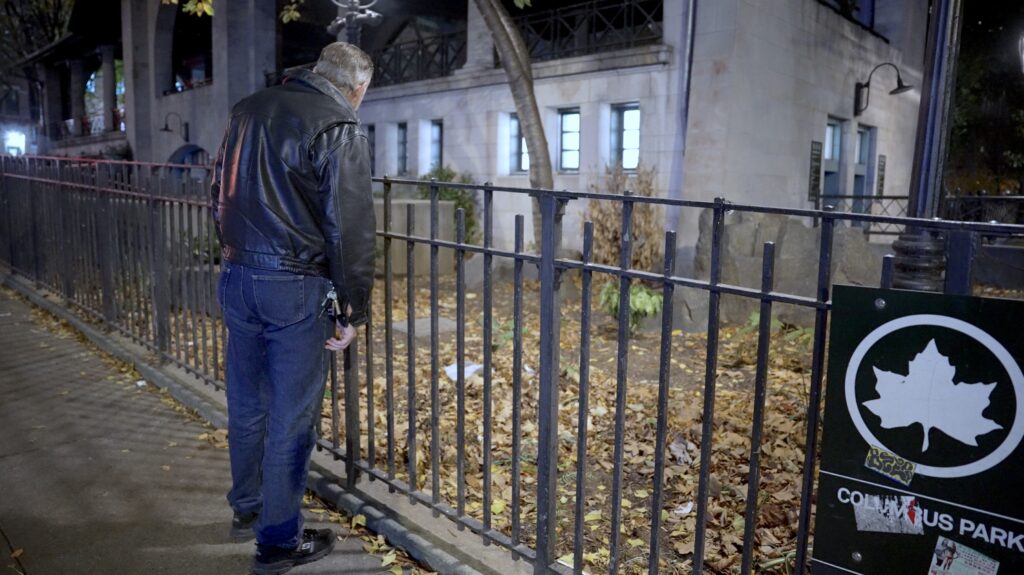
Steven Grey searching for rats on the rat walk. Photo: Assaf Yona Olshansky-Gefen.
Although there is enthusiasm for the Rat Pack, it is admittedly difficult to quantify its success.
There isn’t a good measurement to assess whether or not the Rat Pack is leading to behavioral changes amongst New Yorkers, Bragdon said.
“But people are really engaged and interested, and I think that shows that it’s been a success. We have lots of people participating and lots of people are curious about rats.”
Corradi agreed with Bragdon that the Rat Pack has “absolutely” been a success. In early November, the Rat Pack had its first inauguration event, meaning there are currently around 100 official Rat Pack members.
She highlighted the popularity of the program given that the Rat Pack webpage is the most visited one on the city’s services website.
Other cities are considering a similar approach. For instance, the Boston Rat Action Plan created in July 2024 under Mayor Michelle Wu is actively discussing establishing a “Rat Czar” to run Boston’s initiative.
Only time will tell if the New York City Rat Czar will be successful. The city has been waging wars on rats for decades, and the rodent enemy has come out on top every time.
With Adams’ federal indictment and the competitive mayoral race coming up next year, the future of this program is uncertain. A new administration could alter the rat-fighting strategy significantly.
Corradi acknowledged the difficulty surrounding rat mitigation in a city like New York.
“We’re battling human behavior and human culture, and rats just exploit that. Every inch that we leave rats, they’re gonna take a mile.”
Trash Talkers
Community organizations tackle the litter problem hands-on
By Kellyn Doerr
Catie Savage, the founder and leader of “Litter Legion,” an anti-litter organization, rounded up a group of more than 30 volunteers last month to clean up trash around their neighborhood of Hell’s Kitchen.
She shouted her usual battle cry to the mini-army.
“Are we ready to keep our city clean?”
The small crowd erupted into claps, woos, and yeahs.
Community-based organizations like Catie Savage’s have taken the matter of a littered city into their own hands.
Throughout the year, Savage organizes volunteers to come out and show up for their neighborhood. They grab a couple of gloves and litter grabbers provided by Savage, and, until they feel they’ve done their job, pick up litter themselves.

Photo by: Kellyn Doerr
Savage, who is referred to as the “Trash Queen of Hell’s Kitchen,” started the group in June of 2020 due to pandemic-induced budget cuts at the Department of Sanitation which reduced basket truck services by 67%, she said.
When it comes to New York City as a whole having a littering problem, Savage believes this has been an ongoing issue, and ignored for quite some time, especially after the budget cuts.
“They weren’t doing street sweeping because alternate side parking was paused. They weren’t emptying the public litter baskets as often,” said Savage, “and when more people started going outside, those litter baskets were overflowing, the trash was ending up on the street and blowing around, so we had to go out and start cleaning it up.”
Savage said that despite a lot of the money being refunded, the problem of trash being anywhere but the receptacles, is still ongoing.
“Now that a lot of that money has been refunded, it’s gotten a lot better, but unfortunately, people still litter.”
Rather than ignore the ongoing problem, Savage assembled members of the community to help tackle the problem head-on. Their main work is picking up litter, emptying overflowing baskets, and sorting out recyclables that would otherwise end up in the landfill.
The group has since organized over 100 community cleanup events with over 12,000 pounds of total litter removed. With over 1,600 volunteers having attended past events, citizens of the city are ready to make a difference, and Savage believes it’s not as hard as you may think.

Photo by: Kellyn Doerr
“It’s very easy to find gloves, even if they’re disposable gloves. Everyone should have trash bags at home, go outside with a trash bag, and a pair of gloves and just pick up litter. Or you can join a community cleanup, there’s groups all over the city,” she said.
Savages’ group is not the only one that exists in the Big Apple. Countless community-based organizations lead the way in making sure the extra work in keeping the streets clean is taken care of.
Groups like Clean Up Crown Heights, Nasty New Yorkers, Bed-Stuy Cleanups, NYC CLEAN Volunteers, and many others commit their time and effort to go out and manually do their part in creating a cleaner, healthier city.
There is even the Sanitation Foundation, which is the official nonprofit partner of the Department of Sanitation. The Sanitation Foundation helps support the work of DSNY through manually picking up litter and hosting free educational events about keeping NYC clean.
With over 24 thousand trash baskets distributed across the city, you would think there would be no problem with simply throwing your trash in the bin, but due to overflow and general citizen thoughtlessness, the litter collects all over the sidewalks, streets, and even the parks.
Trash, put simply, is an eyesore. But the litter itself brings many more problems from attracting rats which can spread disease, to groundwater contamination and exposure to toxic chemicals in the city’s green spaces.

Photo by: Kellyn Doerr
You might think deterrents like the Department of Sanitation’s “strict” litter laws would stop New York City residents from discarding their trash all over the city. Fines range from $100–$450 for a first offense and increase for subsequent offenses. But, even as you walk around your own neighborhood, you’re bound to see even a little bit of waste.
I talked to Lower East Side resident, Jack Benson, who is unhappy with his trash bins causing a rodent problem around the area where he lives.
“It’s really gross, it [the trash bins] kind of spills over, and now because of that, there’s become a rat issue,” he said.
When asked how he feels about how the city is handling the litter and trash problem, he feels that his tax money is not going to good use.
“I would say the city could be doing much more with the trash issue. I live in a fairly wealthy neighborhood,” Benson said, “so I’m not sure what the issue is with them not picking up the trash.”
Although Benson said he wants the city to make more publicly available trash bins, he acknowledges that he can’t ignore the issue of the garbage discarded on the streets.
“I think just literally like street litter is more of an issue.”
It’s important to note that the Department of Sanitation has been trying to make strides to help this problem.
This November, the DSNY had a very important proposition on the ballot. Proposition 2 stated they would have increased and clarified authority to keep all city property clean, including parks and highway medians as well as holding street vendors accountable.
What proposition 2 would actually achieve, in more concrete terms, is the following:
● Enable DSNY, at the mayor’s direction, to clean any city-owned property.
● Clarify that DSNY has the authority to require garbage to be containerized.
● Extend DSNY enforcement authority over street vendors to other types of city property, instead of just streets and sidewalks.
Proposition 2 passed with a majority of 61% of the vote.
Although, some groups, like the New York Civil Liberties Union strongly opposed the proposition. They believe this amendment would enforce harsher punishment and surveillance for street vendors, furthering unfair violence and mistreatment.
They also believe it would emphasize the criminalization of poverty through DSNY, by targeting the city’s homeless community by initiating “counterproductive” homeless sweeps.
New York’s ACLU states on its website that propositions 2, 3, 4, 5, and 6, “represent an undemocratic attempt to expand the mayor’s power at the expense of everyday New Yorkers and our elected City Council members.”
Other leaders from anti-littering groups like Alex Bonder, from Clean up Crown Heights, don’t agree with the proposition. Bodner believes that there isn’t a ton of supervision when it comes to new rules like these.
“I was voting no against it,” Bodner said, “Because it was one of those like, take regulation off, so they can do things unfettered and such. In practice you want an organization like DSNY to have the freedom to do what they need to do but, there’s no oversight on that. It’s a little tricky.”
When it comes to vendors and the homeless, Bodner thinks it’s a little more complicated, as the new proposition can’t make any real change or difference without affecting them.
“It’s not a great look right now, those propositions take away the regulation and make it harder to make any real impact without hurting vendors or hurting the houseless,” Bodner said.
All in all, Bodner believes the DSNY doesn’t really need more authority, and the balance of power is a little off.
“They don’t have a structure in place that works entirely. It works, but it could be better. And I don’t know if them having enough power is the core of the issue necessarily,” Bodner said.
Bonder also believes busier areas in the city need more attention, as they produce more trash which tends to overflow.
“Trash cans fill up really quick, and those trash cans that fill up really quick are tended to as quickly. They’re tended to the same way all the other ones are,” Bodner said, “it would be nice if there was more attention to those frequented areas because it does lead to overflow and that overflow just leads to trash not being put in the receptacle.”
Education is key to success, according to Bodner. If people are more aware of how to treat their trash and what to do with the different kinds of trash, litter would be reduced greatly.
“Keeping yourself informed about what is trash and how to deal with the trash,” Bodner said, “and I think like, I don’t know, small steps. What people can do everyday is understand that like, “Oh I can throw this out later” or “I can just put this in my bag” or just bring a bag with you or something like that.”
It seems litter will always be a problem in the concrete jungle until the Department of Sanitation increases penalties or develops even stricter laws for those who do dump their trash anywhere but its designated place.
But for now, anti-littering groups will still do their part to manually get the work done that can’t be helped by trucks or electronics. And Savage believes if we all do our part, our city would be a very different place.
“If every New Yorker kept their little patch of the city clean, we would have a very clean city.”